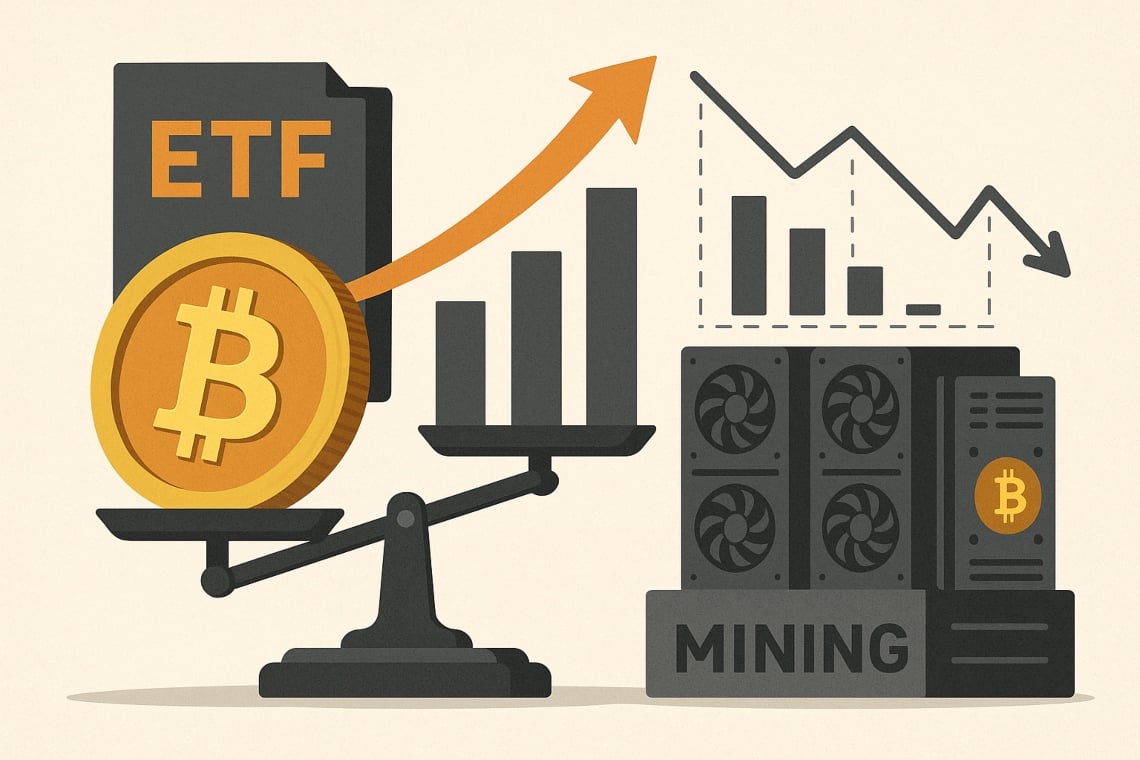institutional demand deflates mining production

The institutional demand for Bitcoin through ETFs has reached an unprecedented level, creating a net imbalance with the production of new digital currency.
Between April 28 and May 2, US ETFs purchased as much as 18,644 BTC, an amount almost six times greater than the 3,150 BTC produced by miners in the same period.
This significant difference represents an unprecedented event: while the daily production of bitcoin stands at around 450 BTC, institutional investors have absorbed the equivalent of over 40 days of mining.
As a result, the ability to create new coins fails to meet the growing demand in the spot market.
Bitcoin ETF Vs miners: a historical gap
The phenomenon is not limited to volumes: the chapter flows confirm the intensity of this interest. In the last five trading days, the funds have recorded a net inflow of 1.8 billion dollars.
Among these, only on April 30 was there a slight outflow, while since April 16, withdrawals have practically disappeared.
This purchasing power impacted the price of Bitcoin, which at the beginning of May saw an increase of about 4%, reaching 97,700 dollars.
Despite the subsequent correction around 94,000 dollars, the scarcity of supply and the growing demand maintain an atmosphere of tension between demand and supply.
The rise of bitcoin ETFs is closely linked to the leadership of the iShares Bitcoin Trust (IBIT) fund by BlackRock.
This single structure has raised almost 2.5 billion dollars in just five days and boasts an impressive series of 17 consecutive days without capital outflows. This data highlights the growing confidence of asset managers in the category.
In total, spot Bitcoin ETFs have surpassed 110 billion dollars in assets under management (AUM). However, a significant limitation remains: many wealth management platforms still do not allow access to these instruments, hindering their spread among retail investors and financial advisors.
If instead these barriers were to fall, the prospects would change radically. Due to the greater access, a new wave of capital flows would be expected, which would amplify volume and liquidity.
As a result, the pressure on mining activities would worsen, while the spot premium of bitcoin could rise further.
How the Bitcoin market will change
The new scenario created by the skewed balance between limited supply and record demand constitutes a historic turning point.
The ability of bitcoin to respond to this growing demand, with mining production remaining steady, will define the short-term trajectory of the price and the spread of this criptovaluta.
It is not specified how the miners intend to react to this unprecedented pressure, but the market tension suggests strong potential fluctuations.
Some analysts speculate that in less than 100 days bitcoin could reach new peaks up to 135,000 dollars, if institutional demand continues to grow without supply being able to adjust.
The current dynamic highlights the importance of ETFs in shaping the cryptocurrency market. They no longer represent just an investment vehicle, but rather a tool capable of absorbing enormous quantities of bitcoin and profoundly influencing price behavior.
Furthermore, this situation highlights a growing institutional participation, which brings with it greater stability but also complexity.
Traditional investors are embracing bitcoin as a value asset, pushing the market towards a maturation that will require organization, regulation, and innovation.
A future of opportunities and challenges
Bitcoin is therefore at a crucial crossroads, marked by a substantially rigid supply and by a rampant institutional demand.
As a result, its evolutionary path in the coming months will be closely watched by investors, regulators, and market operators.
The growth of ETFs could radically transform the ecosystem, offering new investment opportunities to those who were previously excluded. However, it is crucial that financial and regulatory infrastructures adapt to this change to avoid potential tensions or liquidity crises.
The current institutional demand for Bitcoin through ETFs is far exceeding the mining production capacity, generating a new and profound imbalance in the market.
The acceleration of subscriptions and the substantial capital flows indicate an ongoing transformation, which will redefine the role of Bitcoin in the global financial system.
Looking ahead, the removal of entry barriers to ETFs could open the door to an even more intense growth phase. However, it remains essential to monitor market signals and the responses of miners to fully understand future dynamics.
In this context, investors and advisors are called to a careful reflection on opportunities and risks, while industry operators must prepare for a more turbulent market rich in possibilities.
The challenge is open: Bitcoin will no longer be the same, and its future will depend on how well it can balance demand and supply in this new era.